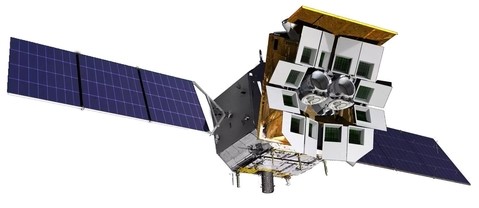Description

Disclaimer: Copyright infringement not intended.
Context
China sent a new astronomical satellite shaped like a lotus into space to observe mysterious transient phenomena in the universe that flicker like fireworks.
Details
- The Einstein Probe (EP) is a pioneering X-ray space telescope mission initiated by the Chinese Academy of Sciences (CAS), in collaboration with the European Space Agency (ESA) and the Max Planck Institute for Extraterrestrial Physics (MPE).
- This mission is specifically dedicated to time-domain high-energy astrophysics, with a primary focus on discovering high-energy transients and monitoring variable celestial objects.
- Named after Albert Einstein, the EP mission pays homage to the great scientist, particularly focusing on predictions from his theory of general relativity related to black holes and gravitational waves.

Instruments
- Lotus-Shaped Structure: Weighing approximately 1.45 tonnes and resembling a full-size SUV, the EP satellite boasts a lotus-shaped design in full bloom. It features 12 petals and two stamens.
- 12 Petals (WXT): The 12 'petals' consist of wide-field X-ray telescopes (WXT), forming a space observatory capable of capturing extensive portions of the sky in one glance.
- 2 Stamens (FXT): The two 'stamens' consist of follow-up X-ray telescopes (FXT), designed for in-depth observation and the discovery of transient celestial objects.
Wide-field X-ray Telescope (WXT):
- Optics Design: Introduces a novel "lobster-eye" optics design, enhancing the field of view for comprehensive sky monitoring.
- Functionality: Equipped for wide-area observation, facilitating the detection of high-energy transients over a broader celestial expanse.
Follow-up X-ray Telescope (FXT):
- Optics Origin: Adopts optics from eROSITA, featuring a mirror module composed of 54 nested Wolter mirrors.
- Capabilities: Offers high sensitivity and rapid follow-up observation, enabling detailed examinations of variable celestial phenomena.
Technological Advancements
- Lobster-Eye Optics: The EP incorporates a cutting-edge lobster-eye optics design in the WXT instrument, first tested by the Lobster Eye Imager for Astronomy (LEIA) mission in 2022. This design enhances the satellite's ability to capture a wider field of view, critical for identifying and studying transient cosmic events.
- Mirror Module for FXT: The FXT utilizes a mirror module derived from eROSITA, comprised of 54 nested Wolter mirrors. This configuration provides an effective area exceeding 300 cm² at 1.5 keV, enhancing the telescope's sensitivity to X-ray emissions.
Other details
- The Einstein Probe has a total weight of 1450 kg and dimensions of 3 by 3.4 meters.
- The EP was launched on January 9, 2024.
- A Long March 2C rocket carried the Einstein Probe into space.
- The Xichang Satellite Launch Centre in China served as the launch site.
- The EP was placed in a low Earth orbit at an altitude of 600 km.
Scientific Objectives
The primary mission of the Einstein Probe is to explore violent cosmic activities, including:
- Supernova Explosions: Capture the first light emanating from supernova explosions to enhance our understanding of these cataclysmic events.
- Gravitational Wave Events: Search for and pinpoint X-ray signals accompanying gravitational wave events, providing valuable insights into the dynamics of spacetime.
- Dormant Black Holes: Discover dormant black holes and other faint transient and variable celestial objects at the far reaches of the universe.
Notable violent phenomena in the universe
Supernovae:
- Description: Supernovae are incredibly energetic explosions that occur when massive stars reach the end of their life cycle. The explosion releases an enormous amount of energy, outshining entire galaxies for a brief period.
- Causes: The collapse of a massive star's core due to gravitational forces, leading to either a Type I or Type II supernova.
- Effects: Creation of heavy elements, shockwaves, and the dispersal of stellar material into space.
Gamma-Ray Bursts (GRBs):
- Description: Gamma-ray bursts are brief but intense bursts of gamma-ray radiation, often originating from distant galaxies.
- Causes: The exact causes are still under investigation, but they are associated with massive star collapses, neutron star mergers, or black hole formations.
- Effects: Release of energy equivalent to the entire observable universe, formation of black holes or neutron stars.
Quasars:
- Description: Quasars are extremely bright and energetic centers of distant galaxies, powered by supermassive black holes.
- Causes: Accretion of mass onto supermassive black holes, leading to the emission of vast amounts of energy.
- Effects: Illumination of surrounding gas and dust, formation of relativistic jets, and influence on galaxy evolution.
Neutron Star Collisions:
- Description: When two neutron stars orbit each other and eventually merge, it results in a cataclysmic event known as a kilonova.
- Causes: Orbital decay due to gravitational wave emission, leading to the merger of neutron stars.
- Effects: Release of gravitational waves, heavy element synthesis (such as gold and platinum), and potential formation of a black hole.
Galactic Cannibalism:
- Description: Larger galaxies can consume smaller galaxies in a process known as galactic cannibalism.
- Causes: Gravitational interactions between galaxies leading to mergers.
- Effects: Redistribution of stars, gas, and dark matter; triggering of star formation.
Black Hole Activities:
- Description: Black holes can exhibit violent behaviors, such as accretion disk formation, relativistic jets, and gravitational waves.
- Causes: Accretion of mass, interactions with nearby objects, or mergers with other black holes.
- Effects: Emission of intense radiation, formation of powerful jets, and ripples in spacetime (gravitational waves).
Cosmic Ray Showers:
- Description: High-energy particles from space, called cosmic rays, can collide with Earth's atmosphere, initiating cascades of secondary particles known as cosmic ray showers.
- Causes: Originating from sources like supernovae remnants, active galactic nuclei, and gamma-ray bursts.
- Effects: Induction of nuclear reactions, production of secondary particles, and influence on atmospheric chemistry.

Conclusion
The launch of the Einstein Probe represents a crucial step in unraveling the mysteries of the violent cosmos. As the satellite begins its mission, scientists anticipate groundbreaking discoveries that will contribute to our understanding of the fundamental questions surrounding the composition of the universe, the laws governing extreme cosmic phenomena, and the evolution and demise of stars.
|
PRACTICE QUESTION
Q. Examine the significance of recent advancements in space-based observatories, such as the Einstein Probe, in enhancing our understanding of violent phenomena in the universe. (250 Words)
|
















